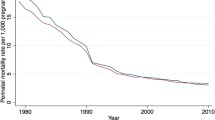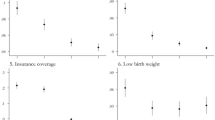Abstract
Trends in stillbirth rates, perinatal, neonatal and postneonatal mortality in Italy over the perrod 1955–84 were analyzed. There was a 75% reduction (from 28.4 to 7.1/1000 births) in stillbirth rates, and a nearly 70% fall (from 46.2 to 14.5/1000 births) in overall perinatal mortality (from the 180th day of pregnancy to the first week of life). Further, mortality rates from the 8th to the 28th day of life dropped from 7.4 to 1.6/1000 livebirths, and mortality from the second month to the first year of life from 25.1 to 2.2/1000 livebirths. The fall in stillbirth rates was similarly evident across various indicators of maternal education and social class, and could only marginally be accounted for by changes in maternal age distribution. The causes of this large drop in perinatal, neonatal and postneonatal mortality are likely to be numerous and complex. In the absence of any comprehensive program of rationalization of obstetrical and neonatal care, a determinant role must have been played by a general improvement in economic and cultural conditions. However, the observation that decreased perinatal mortality was not due to a decline in the proportion of low birth weight indicates that improved perinatal care may have had an important role as well.
Although the decrease in various measures of perinatal and postneonatal mortality in Italy was proportionally comparable with that registered in several other developed countries, Italian perinatal mortality rates (14.5/1000 births in 1984) still appear considerably higher than in other countries, and are clearly far from the optimal theoretical value.
Résumé
Les évolutions de la mortinatalité et des mortalités périnatale, néonatale et postnéonatale en Italie entre 1955 et 1984 ont été analysées. La mortinatalité a été réduite de 75% (de 28,4 à 7,1‰) et la mortalité périnatale de 70% (de 46,2 à 14,5‰). Les taux de mortalité entre le 8c et le 28c jour de vie sont tombés de 7,4 à 1,6‰, et la mortalité entre le deuxième mois et la fin de la première année de vie de 25,1 à 2,2‰. La chute de la mortinatalité est semblable parmi les différentes strates du niveau d'éducation maternel et de la classe sociale, et le changement de la distribution des âges maternels n'influe que marginalement dans cette évolution. Les raisons de cette importante chute des mortalités périnatale, néonatale et postnéonatale sont vraisemblablement nombreuses et complexes. L'absence de tout programme explicite d'amélioration des soins obstétricaux et néonatals rend vraisemblable le rôle déterminant qu'a dû jouer l'amélioration générale des conditions économiques et culturelles. Cependant, le fait que la chute de la mortalité périnatale n'est pas attribuable à une diminution de la proportion des faibles poids de naissance indique qu'une amélioration des soins périnataux a pu également jouer un rôle important. Bien que cette évolution favorable des mortalités périnatale et postnéonatale en Italie soit comparable à celles observées dans d'autres pays développés, les taux italiens de mortalité périnatale (14,5‰ en 1984) sont considérablement plus hauts que ceux d'autres pays et clairement loin d'avoir atteint une valeur optimale.
Zusammenfassung
Analysiert wurden die Entwicklung der Totgeburtenziffer und der perinatalen, neonatalen und der postneonatalen Sterblichkeit in Italien zwischen 1955 und 1984. Für die Totgeburtenziffer wurde ein Rückgang von 75% (von 28,4 auf 7,1‰), für die perinatale Sterblichkeit von 70% beobachtet (von 46,2 auf 14,5‰). Die Sterblichkeit zwischen dem 8. und 28. Lebenstag ist von 7,4 auf l,6‰, die Sterblichkeit in der Zeit vom 2. Monat bis zum Ende des ersten Lebensjahres von 25,1 auf 2,2‰ gefallen. Der Rückgang der Totgeburten findet sich bei den Müttern unterschiedlicher Ausbildungsgrade und verschiedener soziokultureller Schichten gleichermassen und dann durch eine Veränderung in der Altersstruktur der Mütter nur teilweise erklärt werden. Die Gründe für diesen bemerkenswerten Rückgang der perinatalen, neonatalen und postneonatalen Sterblichkeit dürften zahlreich und komplex sein. Da es kein Programm zur Verbesserung der geburtshilflichen und neonatalen Pflege gibt, liegt die Vermutung nahe, dass die allgemeine Veränderung der wirtschaftlichen und sozialen Bedingungen eine entscheidende Rolle gespielt hat. Die Tatsache allerdings, dass der Abfall der perinatalen Sterblichkeit nicht auf einer Abnahme des Anteils von Kindern mit niedrigem Geburtsgewicht beruht, zeigt, dass die verbesserte perinatale Pflege ebenfalls von Bedeutung ist. Obwohl der Rückgang der perinatalen und postneonatalen Sterblichkeit in Italien vergleichbar ist mit jenem in anderen entwickelten Ländern, ist die neonatale Sterblichkeit (14,5‰ im Jahre 1984) doch noch beträchtlich höher als in anderen Ländern und weit von den Idealwerten entfernt.
Similar content being viewed by others
References
Chamberlain G.: Background to perinatal health. Lancet 1979;2: 1061–1063.
Rooth G.: Better Perinatal Health. Sweden. Lancet 1979;2: 1170–1172.
Beaufils F., Boué A.: Better Perinatal Health. France. Lancet 1979;2: 1352–1353.
Hobel C.J.: Better Perinatal Health. USA. Lancet 1980;1: 31–33.
Lumley J.: Better Perinatal Health. Australia. Lancet 1980;1: 79–81.
Parazzini F., Negrello I., La Vecchia C.: Trends in stillbirths and mortality during the first year of life in various Italian regions: 1955–1979. Ann. Ostet. Ginecol. Med. Perinat. 1986;107: 5–120.
ISTAT: Annuario di Statistiche Demografiche, Vol. IV-XX-VIII edition 1955–1981; Roma, 1958–1985.
ISTAT: Bollettino Mensile di Statistica. Various issues; Roma, 1982–1985.
ISTAT: Recenti Livelli e Caratteristiche della Mortalità Infantile in Italia. Collana di Informazioni 1983; Anno VII No. 4.
Macfarlane A., Mugford M.: Birth Counts. Statistics of Pregnancy and Childbirth. Her Majesty's Stationery Office: London, 1984.
Khoury M.J., Erickson J.D., Adams M.J. Jr.: Trends in postneonatal mortality in the United States. 1962 through 1978. JAMA 1984;252: 367–372.
Pharoah P.O.D., Morris J.N.: Postneonatal mortality. Epidemiol. Rev. 1979;1: 170–183.
Eisner V., Pratt M.W., Hexter A., Chabot M.J., Sayal N.: Improvement in infant and perinatal mortality in the United States, 1965–1973: I. Priorities for intervention. Am. J. Public Health 1978;68: 359–366.
Erickson J.D., Bjerkedal T.: Fetal and infant mortality in Norway and the United States. JAMA 1982;247:987–991.
Bundesamt für Statistik: Geburtsgewicht und Säuglingssterblichkeit in der Schweiz. 1979–1981. Beiträge zur schweizerischen Statistik/Heft 126. Bern, 1985.
Dambrosio F.: Metodologia della pianificazione sanitaria. La mortalità perinatale e infantile in Lombardia. The Practitioner Ed. Italiana, 1983; No.61:32–51.
La Vecchia C.: Patterns of cigarette smoking and trends in lung cancer mortality in Italy. J. Epidemiol. Community Health 1985;39: 157–164.
Author information
Authors and Affiliations
Rights and permissions
About this article
Cite this article
Parazzini, F., Imazio, C., Pampallona, S. et al. Trends in perinatal, neonatal and postneonatal mortality in Italy, 1955–84. Soz Präventivmed 32, 286–290 (1987). https://doi.org/10.1007/BF02078162
Issue Date:
DOI: https://doi.org/10.1007/BF02078162




